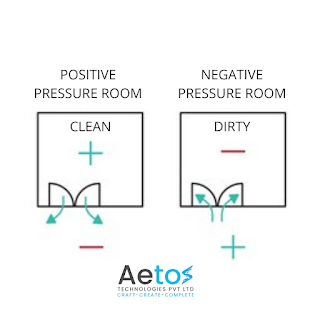HOW DOES AIR PRESSURE IN CLEANROOMS
WORK?
The passage of air from high to low pressure is a well-known
natural phenomenon. Every day, we are surrounded by examples of this. Wind and
weather are created as the earth’s surface heats unevenly, resulting in pockets
of high and low-pressure air. If you’ve ever seen a door suddenly close as air
is sucked out of a room where there was no breeze, you’ve seen high-pressure
air traversing to a low-pressure place to achieve stasis. The air escaping from
from a high-pressure environment to the relatively low-pressure environment
around it.
When air is travelling in one direction, it does not move in the
opposite direction in any of these conditions. As long as the air inside the
balloon is more pressured, there is no air coming into the balloon when air is
moving out of it. This technique can be used in cleanrooms to block the flow of
air into or out of the room, minimizing particle transmission and ensuring a
cleaner environment.
To put it another way, higher pressure air within a cleanroom
(as compared to outside air) prevents pollutants from entering the cleanroom
because air naturally wants to flow out. Lower pressure air in a clean room, on
the other hand, can trap pollutants and prevent them from exiting because the
natural flow of air wants to move in.
Pressure in cleanrooms, either higher (positive pressure) or
lower (negative pressure), can be quite useful in a variety of cleanroom
applications – but how do you include it into the cleanroom design?
v USING PRESSURE IN CLEANROOM DESIGN
Controlling how much air is pumped into the cleanroom and how
much is evacuated creates positive and negative pressure in cleanrooms.
Clean, filtered air is continually pushed into a positive
pressure cleanroom via the HEPA filtration and clean room HVAC system. If a door
or window in the cleanroom were to be opened, air would rush out into the
outside world or recirculate through the AHUs.
This positive pressure ensures that the products and operations
within the cleanroom are safeguarded in the case of a breach or leak. The air
is driven out of the cleanroom due to the positive pressure, preventing
contaminated or unfiltered air from entering.
External exhausts draw air from the cleanroom at a higher rate
than air is added over time to generate negative air pressure. As a result of
the negative pressure, air will desire to flow into the cleanroom to fill the
low-pressure space, thereby preventing pollutants from escaping the cleanroom
against the natural flow.
Cleanrooms require neighboring spaces to be kept at a lower or
higher pressure than the cleanroom to maintain positive or negative pressure.
If you incorporate a pressurization system into your cleanroom
design, a pressure monitoring system is essential for maintaining balance and
consistency. The pressure will be checked and maintained by the monitoring
system, which can be adjusted manually or automatically.
v POSITIVE PRESSURE CLEANROOM APPLICATIONS
Positive pressure cleanrooms, also known as high-pressure
cleanrooms, are highly beneficial in applications where even the tiniest
particle interference could damage cleanroom procedures. Positive pressure
cleanrooms are beneficial to businesses that are particularly resistant to
contaminating particles, such as semiconductor cleanrooms, microprocessor
cleanrooms, and aerospace and defense cleanrooms. Positive pressure is used in
many medical cleanrooms to protect delicate patients and maintain a controlled
environment.
Using slightly positive pressure in cleanrooms can assist
achieve cleanroom classifications and maintaining a cleaner environment even
when the stakes aren’t nearly as high.
v NEGATIVE PRESSURE CLEANROOM APPLICATIONS
Low-pressure cleanrooms, also known as negative-pressure
cleanrooms, are appropriate for applications that require the isolation of substances,
particles, or fumes inside the cleanroom environment to safeguard the
environment outside the cleanroom. They’re commonly utilized in medical
cleanrooms, as well as for medical research, testing, and the development of
sensitive-substance treatments.
Negative pressure is also used in cleanrooms for pharmaceutical
purposes as part of a segmented arrangement. Lower pressure is maintained in
one chamber, while a slightly higher pressure is maintained in the ante-room
directly outside. This permits staff to enter the negative pressure area with
as little disruption as possible.
In cleanroom environments, high and low pressure, or positive
and negative pressure, can both be employed as instruments to defend against
entering contaminants (in positive pressure cleanrooms) or contaminant leakage
(in negative pressure cleanrooms) (in negative pressure cleanrooms). We can
create cleaner, safer cleanrooms by utilizing the natural movement of air
caused by pressure.
Reach out to Aetos
Technologies Pvt. Ltd. for any cleanroom-related solution, Lets connect
at
sa***@ae*******.in
or visit www.aetostech.in

